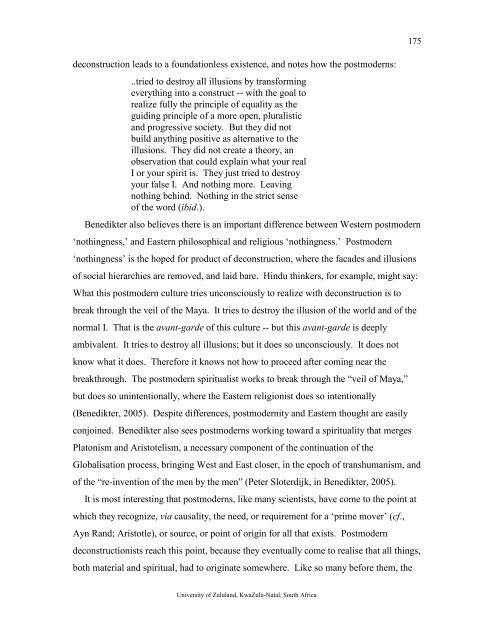Haase_UZ_x007E_DTh (2).pdf - South African Theological Seminary
Haase_UZ_x007E_DTh (2).pdf - South African Theological Seminary
Haase_UZ_x007E_DTh (2).pdf - South African Theological Seminary
Create successful ePaper yourself
Turn your PDF publications into a flip-book with our unique Google optimized e-Paper software.
deconstruction leads to a foundationless existence, and notes how the postmoderns:<br />
..tried to destroy all illusions by transforming<br />
everything into a construct -- with the goal to<br />
realize fully the principle of equality as the<br />
guiding principle of a more open, pluralistic<br />
and progressive society. But they did not<br />
build anything positive as alternative to the<br />
illusions. They did not create a theory, an<br />
observation that could explain what your real<br />
I or your spirit is. They just tried to destroy<br />
your false I. And nothing more. Leaving<br />
nothing behind. Nothing in the strict sense<br />
of the word (ibid.).<br />
Benedikter also believes there is an important difference between Western postmodern<br />
‘nothingness,’ and Eastern philosophical and religious ‘nothingness.’ Postmodern<br />
‘nothingness’ is the hoped for product of deconstruction, where the facades and illusions<br />
of social hierarchies are removed, and laid bare. Hindu thinkers, for example, might say:<br />
What this postmodern culture tries unconsciously to realize with deconstruction is to<br />
break through the veil of the Maya. It tries to destroy the illusion of the world and of the<br />
normal I. That is the avant-garde of this culture -- but this avant-garde is deeply<br />
ambivalent. It tries to destroy all illusions; but it does so unconsciously. It does not<br />
know what it does. Therefore it knows not how to proceed after coming near the<br />
breakthrough. The postmodern spiritualist works to break through the “veil of Maya,”<br />
but does so unintentionally, where the Eastern religionist does so intentionally<br />
(Benedikter, 2005). Despite differences, postmodernity and Eastern thought are easily<br />
conjoined. Benedikter also sees postmoderns working toward a spirituality that merges<br />
Platonism and Aristotelism, a necessary component of the continuation of the<br />
Globalisation process, bringing West and East closer, in the epoch of transhumanism, and<br />
of the “re-invention of the men by the men” (Peter Sloterdijk, in Benedikter, 2005).<br />
It is most interesting that postmoderns, like many scientists, have come to the point at<br />
which they recognize, via causality, the need, or requirement for a ‘prime mover’ (cf.,<br />
Ayn Rand; Aristotle), or source, or point of origin for all that exists. Postmodern<br />
deconstructionists reach this point, because they eventually come to realise that all things,<br />
both material and spiritual, had to originate somewhere. Like so many before them, the<br />
175<br />
University of Zululand, KwaZulu-Natal, <strong>South</strong> Africa

















